 |
| Algol in Perseus |
The more massive star of the pair is still on the main sequence, but the less massive one has already evolved to become a subgiant. This presents a paradox because usually more massive stars evolve faster. The solution is that Algol B has lost mass to Algol A. The current secondary star was at one time the more massive and as it evolved off the main sequence and swelled it lost mass to its companion and become the secondary star.
When a star loses mass to its partner, not only does the mass transfer change the stars themselves, it also changes their orbit. When the more massive star transfers mass to the less massive star, their masses come closer together, and also their orbit shrinks bringing the stars themselves closer to together. As you might imagine, this will encourage further mass transfer.
One would think that this process would end when the two stars had equal masses. Thereafter, further mass transfer would cause the orbit to grow. This is correct; however, the donor star could swell further (and even swell as it loses mass) so the mass may continue to flow from the less massive star to the more massive star, even though the orbit starts to grow again. This is probably what happened with Algol A and B. By the way there is also an Algol C that orbits around the other two stars with a period of nearly two years --- it is quite far away compared to the others. Its orbit would remain more or less the same in spite of the shenanigans of the other two stars.
Perhaps I will catch a fainter Algol in a subsequent photo --- I have a one in seven chance!








